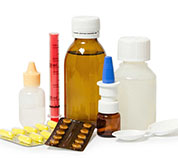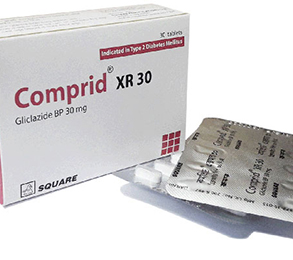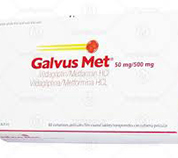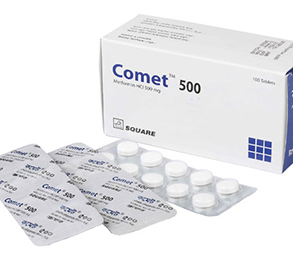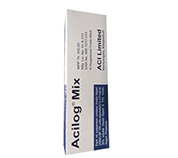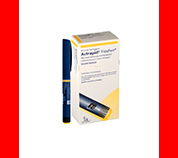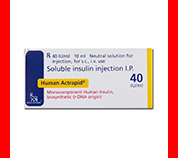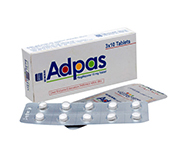Amaryl M 1 mg+500 mg 10 Pcs
Alternative products
Glimepiride + Metformin
Indications
This tablet is indicated as an adjunct to diet and exercise in type 2 diabetes mellitus patients-
- In case that the monotherapy with glimepiride or metformin does not result in adequate glycemic control.
- Replacement of combination therapy of glimepiride and metformin.
Pharmacology
Glimepiride is a sulfonylurea antidiabetic agent which decreases blood glucose concentration. The primary mechanism of action of Glimepiride appears to be dependent on stimulating the release of insulin from functioning pancreatic beta cells. Glimepiride acts in concert with glucose by improving the sensitivity of beta cells to physiological glucose stimulus, resulting in insulin secretion. In addition, extrapancreatic effects like reduction of basal hepatic glucose production, increased peripheral tissue sensitivity to insulin and glucose uptake may also play role in the activity of Glimepiride. In non-fasting diabetic patients, the hypoglycaemic action of a single dose of Glimepiride persists for 24 hours.
Metformin Hydrochloride is a biguanide type oral antihyperglycemic drug used in the management of type 2 diabetes. It lowers both basal and postprandial plasma glucose. Its mechanism of action is different from those of sulfonylureas and it does not produce hypoglycemia. Metformin Hydrochloride decreases hepatic glucose production, decreases intestinal absorption of glucose and improves insulin sensitivity by an increase in peripheral glucose uptake and utilization.
Dosage
- The dosage of this tablet is governed by the desired blood glucose level. The dosage of this tablet must be the lowest which is sufficient to achieve the desired metabolic control. During treatment with this tablet glucose levels in blood and urine must be measured regularly.
- Mistakes, e.g. forgetting to take a dose, must never be corrected by subsequently taking a larger dose.
- As an improvement in control of diabetes is, in itself, associated with higher insulin sensitivity, glimepiride requirements may fall as treatment proceeds. To avoid hypoglycaemia timely dose reduction or cessation of this tablet therapy must therefore be considered.
- The highest recommended dose per day should be 8 mg of glimepiride and 2000 mg of metformin.
- In order to avoid hypoglycaemia the starting dose of this tablet should not exceed the daily doses of glimepiride or metformin already being taken.
- When switching from combination therapy of glimepiride plus metformin as separate tablets, this combination should be administered on the basis of dosage currently being taken.
* চিকিৎসকের পরামর্শ মোতাবেক ঔষধ সেবন করুন'
Administration
This tablet must be swallowed whole and not crushed or chewed.
* চিকিৎসকের পরামর্শ মোতাবেক ঔষধ সেবন করুন'
Interaction
For Glimepiride:
- Glimepiride is metabolized by cytochrome P450 2C9 (CYP2C9). This should be taken into account when glimepiride is coadministered with inducers (e.g. rifampicin) or inhibitors (e.g. fuconazole) of CYP 2C9.
- Potentiation of the blood-glucose-lowering efect and, thus, in some instances hypoglycaemia may occur when one of the following drugs is taken, for example: insulin and other, oral antidiabetics; ACE inhibitors; anabolic steroids and male sex hormones; chloramphenicol; coumarin derivatives; cyclophosphamide; disopyramide; fenfuramine; fenyramidol; fbrates; fuoxetine; guanethidine; ifosfamide; MAO inhibitors; miconazole; fuconazole; para-aminosalicylic acid; pentoxifylline (high dose parenteral); phenylbutazone; azapropazone; oxyphenbutazone; probenecid; quinolones; salicylates; sulfnpyrazone; clarithromycin; sulfonamide antibiotics; tetracyclines; tritoqualine; trofosfamide.
- Weakening of the blood-glucose-lowering efect and, thus raised blood glucose levels may occur when one of the following drugs is taken, for example: acetazolamide; barbiturates; corticosteroids; diazoxide; diuretics; epinephrine (adrenaline) and other sympathomimetic agents; glucagon; laxatives (after protracted use); nicotinic acid (in high doses); oestrogens and progestogens; phenothiazines; phenytoin; rifampicin; thyroid hormones.
- H2 receptor antagonists, beta-blockers, clonidine and reserpine may lead to either potentiation or weakening of the blood-glucose-lowering efect. Under the infuence of sympatholytic drugs such as beta-blockers, clonidine, guanethidine and reserpine, the signs of adrenergic counter-regulation to hypoglycaemia may be reduced or absent.
- Both acute and chronic alcohol intake may potentiate or weaken the blood-glucose-lowering action of glimepiride in an unpredictable fashion.
- The efect of coumarin derivatives may be potentiated or weakened.
- Bile acid sequestrant: Colesevelam binds to glimepiride and reduces glimepiride absorption from the gastrointestinal tract. Glimepiride should be administered at least 4 hours prior to colesevelam.
For Metformin: Concomitant use not recommended:
- Alcohol: Alcohol intoxication is associated with an increased risk of lactic acidosis, particularly in case of fasting, malnutrition or hepatic insufciency. Avoid consumption of alcohol and alcohol-containing medications
- Iodinated contrast agents: Metformin must be discontinued prior to, or at the time of the imaging procedure and not restarted until at least 48 hours after, provided that renal function has been re-evaluated and found to be stable.
- Combinations requiring precautions for use: Some medicinal products can adversely afect renal function which may increase the risk of lactic Acidosis. When starting or using such products in combination with metformin, close monitoring of renal function is necessary. Glucocorticoids, beta-2-agonists, and diuretics have intrinsic hyperglycemic activity. Inform the patient and perform more frequent blood glucose monitoring. ACE-inhibitors may decrease the blood glucose levels. Metformin may decrease the anticoagulant efect of phenprocoumon. Therefore, a close monitoring of the INR is recommended. Levothyroxine can reduce the hypoglycemic efect of metformin. Monitoring of blood glucose levels is recommended, especially when thyroid hormone therapy is initiated or stopped, and the dosage of metformin must be adjusted if necessary.
Organic cation transporters (OCT): Metformin is a substrate of both transporters OCT1 and OCT2. Co-administration of metformin with:
- Inhibitors of OCT1 (such as verapamil) may reduce efcacy of metformin.
- Inducers of OCT1 (such as rifampicin) may increase gastrointestinal absorption and efcacy of metformin.
- Inhibitors of OCT2 (such as cimetidine, dolutegravir, ranolazine, trimethoprime, vandetanib, isavuconazole) may decrease the renal elimination of metformin and thus lead to an increase in metformin plasma concentration.
- Inhibitors of both OCT1 and OCT2 (such as crizotinib, olaparib) may alter efcacy and renal elimination of metformin.
Caution is therefore advised, especially in patients with renal impairment, when these drugs are coadministered with metformin, as metformin plasma concentration may increase. If needed, dose adjustment of metformin may be considered as OCT inhibitors/inducers may alter the efcacy of metformin.
Contraindications
For Glimepiride-
- In patients hypersensitive to glimepiride, metformin, other sulfonylureas, other sulfonamides, or any of the excipients of Amaryl M.
- In pregnant women.
- In breastfeeding women.
No experience has been gained concerning the use of glimepiride in patients with severe impairment of liver function and in dialysis patients. In patients with severe impairment of hepatic function, change-over to insulin is indicated, not least to achieve optimal metabolic control.
For Metformin-
- Hypersensitivity to metformin or any of the excipients.
- Any type of acute metabolic acidosis such as lactic acidosis Diabetic ketoacidosis, diabetic pre-coma.
- Severe Renal failure or renal disfunction (e.g., serum creatine levels >135 μmol/L in males and >110 μmol/L in females), GFR < 30 mL/min.
- Acute conditions with the potential to alter renal function such as Dehydration, severe infection, intravascular administration of iodinated contrast agents etc.
- Acute or chronic disease which may cause tissue hypoxia such as cardiac or respiratory failure, recent myocardial infarction, shock
- Hepatic insufciency.
- Acute alcohol intoxication, alcoholism.
- Lactation.
Side Effects
For Glimepiride:
Metabolism and nutrition disorders-
- As a result of the blood-glucose-lowering action of glimepiride, Hypoglycaemia which may also be prolonged.
- The clinical picture of a severe hypoglycaemic attack may resemble that of a stroke.
Eye disorders: Especially at the start of treatment, there may be temporary visual impairment due to the change in blood glucose levels. The cause is a temporary alteration in the turgidity and hence the refractive index of the lens, this being dependent on blood glucose level.
Gastrointestinal disorders-
- Occasionally, Gastrointestinal symptoms such as nausea, vomiting, sensations of pressure or fulness in the epigastrium, abdominal pain and diarrhea may occur.
- In isolated cases, there may be hepatitis, elevation of liver enzyme levels and/or cholestasis and jaundice, which may progress to life-threatening liver failure.
- Dysgeusia (frequency not known)
Blood and lymphatic system disorders-
- Changes in the blood picture may occur: Rarely, thrombocytopenia and, in isolated cases, leucopenia, hemolytic anemia, erythrocytopenia, granulocytopenia, agranulocytosis or pancytopenia may develop. Cases of severe thrombocytopenia with platelet count less than 10,000/μl and thrombocytopenic purpura have been reported in post-marketing experience (frequency not known).
Skin and subcutaneous tissue disorders: Alopecia (frequency not known)
General disorders-
- Occasionally, Allergic or pseudo allergic reactions may occur, e.g. in the form of itching, urticaria or rashes. Such mild reactions may develop into serious reactions with dyspnoea and a fall in blood pressure, sometimes progressing to shock.
- In isolated cases, a decrease in serum sodium concentration and allergic vasculitis or hypersensitivity of the skin to light may occur.
Investigations: Glimepiride, like all sulfonylureas, can cause weight gain (frequency not known)
For Metformin:
- Gastrointestinal symptoms such as nausea, vomiting, diarrhoea, abdominal pain and loss of appetite (>10%) are very common. These occur most frequently during initiation of therapy and resolve spontaneously in most cases.
- Metallic taste (3%) is common
- Decrease of vitamin B12 absorption with decrease of serum levels has been observed in patients treated long-term with metformin and appears generally to be without clinical signifcance (<0.01%). However, Cases of peripheral neuropathy in patients with vitamin B12 defciency have been reported in post-marketing experience (frequency not known). (frequency unknown)
- Lactic acidosis (0.03 cases/1000 patient-years) is very rare
- Hemolytic anemia (frequency unknown)
- Reduction of thyrotropin level in patients with hypothyroidism (frequency unknown)
- Hypomagnesemia in the context of diarrhea (frequency unknown)
- Encephalopathy (frequency unknown)
- Photosensitivity (frequency unknown)
- Hepatobiliary disorders: Reports of liver function tests abnormalities and hepatitis resolving upon metformin discontinuation
Pregnancy & Lactation
Pregnancy-
- For Glimepiride: Glimepiride must not be taken during pregnancy. Otherwise, there is risk of harm to the child. The patient must change over to insulin during pregnancy. Patients planning a pregnancy must inform their physician. It is recommended that such patients change over to insulin.
- For Metformin: When the patient plans to become pregnant and during pregnancy, diabetes should not be treated with metformin but insulin should be used to maintain blood glucose levels as close to normal as possible in order to lower the risk of fetal malformations associated with abnormal blood glucose levels.
Lactation-
- For Glimepiride: To prevent possible ingestion with the breast milk and possible harm to the child, glimepiride must not be taken by breast-feeding women. If necessary the patient must change over to insulin, or must stop breastfeeding.
- For Metformin: Metformin is excreted into milk in lactating rats. Similar data is not available in humans and a decision should be made whether to discontinue nursing or to discontinue metformin, taking into account the importance of the compound to the mother.
Precautions & Warnings
For Glimepiride: In the initial weeks of treatment, the risk of hypoglycemia may be increased and necessitates especially careful monitoring. If risk factors for hypoglycemia are present, it may be necessary to adjust the dosage of glimepiride or the entire therapy. This also applies whenever illness occurs during therapy or the patient's life-style changes. It is known from other sulfonylureas that, despite initially successful countermeasures, hypoglycaemia may recur. Patients must, therefore, remain under close observation. Severe hypoglycaemia further requires immediate treatment and follow-up by a physician and, in some circumstances, in-patient hospital care. Treatment of patients with G6PD-defciency with sulfonylurea agents can lead to hemolytic anaemia. Since glimepiride belongs to the class of sulfonylurea agents, caution should be used in patients with G6PD-defciency and a non-sulfonylurea alternative should be considered.
For Metformin: Regular monitoring of thyroid-stimulating hormone (TSH) levels is recommended in patients withhypothyroidism. Long-term treatment with metformin has been associated with a decrease in vitamin B12 serumlevels which may cause peripheral neuropathy. Monitoring of the vitamin B12 level is recommended.
Use in Special Populations
Children: Data is insufficient to recommend pediatric use of this tablet.
Renal impairment: A GFR should be assessed before initiation of treatment with metformin-containing products and at least annually thereafter. In patients at increased risk of further progression of renal impairment and in the elderly, renal function should be assessed more frequently, e.g. every 3-6 months. The maximum daily dose of metformin should preferably be divided into 2-3 daily doses. Factors that may increase the risk of lactic acidosis should be reviewed before considering the initiation of metformin in patients with GFR<60 mL/min. If no adequate strength of this tablet is available, individual monocomponents should be used instead of the fixed dose combination.
GFR 60-89 ml/min:
- Metformin: Maximum daily dose is 3000 mg. Dose reduction may be considered in relation to declining renal function.
- Glimepiride: The highest recommended dose per day should be 8 mg of glimepiride.
GFR 45-59 ml/min:
- Metformin: Maximum daily dose is 2000 mg. The starting dose is at most half of the maximum dose.
GFR 30-44 ml/min:
- Metformin: Maximum daily dose is 1000 mg. The starting dose is at most half of the maximum dose.
GFR <30 ml/min:
- Metformin: Metformin is contraindicated
- Glimepiride: Change-over to insulin is indicated, not least to achieve optimal metabolic control.
Overdose Effects
For Glimepiride: Acute overdosage, as well as long-term treatment with too high a dose of glimepiride, may lead to severe life-threatening hypoglycaemia. As soon as an overdose of glimepiride has been discovered, a physician must be notifed without delay. The patient must immediately take sugar, if possible in the form of glucose unless a physician has already undertaken responsibility for treating the overdose. Careful monitoring is essential until the physician is confdent that the patient is out of danger. It must be remembered that hypoglycaemia may recur after initial recovery. Admission to hospital may sometimes be necessary even as a precautionary measure. In particular, signifcant overdoses and severe reactions with signs such as loss of consciousness or other serious neurological disorders are medical emergencies and require immediate treatment and admission to hospital. If, for example, the patient is unconscious, an intravenous injection of concentrated glucose solution is indicated (for adults starting with 40 ml of 20% solution, for example). Alternatively in adults, administration of glucagon, e.g. in doses of 0.5 to 1 mg i.v., s.c. or i.m., may be considered. In particular when treating hypoglycaemia due to accidental intake of glimepiride in infants and young children, the dose of glucose given must be very carefully adjusted in view of the possibility of producing dangerous hyperglycaemia, and must be controlled by close monitoring of blood glucose. Patients who have ingested life-threatening amounts of glimepiride require detoxifcation (e.g. by gastric lavage and medicinal charcoal). After acute glucose replacement has been completed it is usually necessary to give an intravenous glucose infusion in lower concentration so as to ensure that the hypoglycaemia does not recur. The patient's blood glucose level should be carefully monitored for at least 24 hours. In severe cases with a protracted course, hypoglycaemia, or the danger of slipping back into hypoglycaemia, may persist for several days.
For Metformin: Hypoglycaemia has not been seen with metformin doses of up to 85 g, although Lactic acidosis has occurred in such circumstances. High overdose or concomitant risks of metformin may lead to lactic acidosis Lactic acidosis is a medical emergency and must be treated in hospital. The most efective method to remove lactate and metformin is haemodialysis. Pancreatitis may occur in the context of a metformin overdose.
Therapeutic Class
Combination Oral hypoglycemic preparations
Storage Conditions
Store in a cool (not exceeding 25°C) and dry place, protected from light.
- Type Tablet
- Tag
- Morbi leo risus
- Porta ac consectetur ac
- Vestibulum at eros


